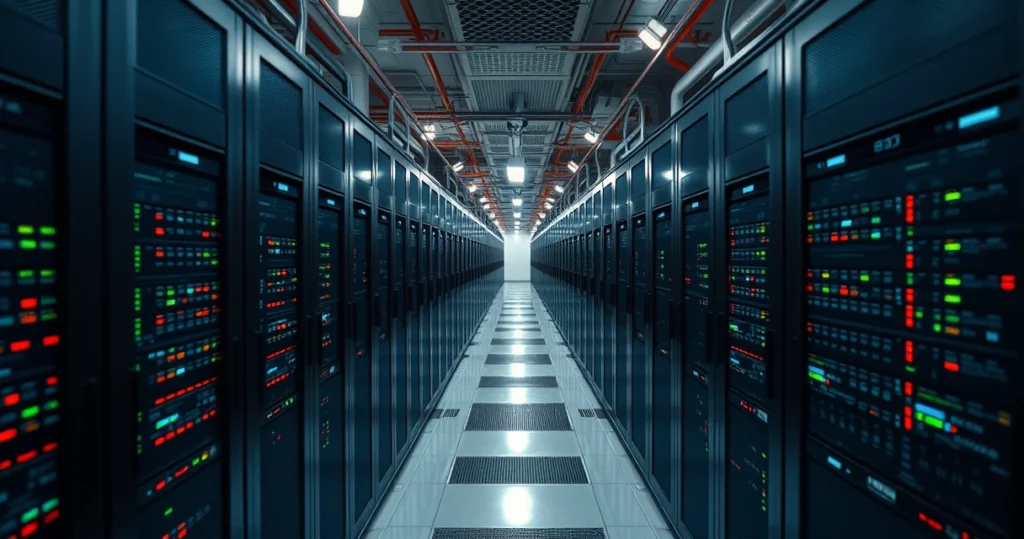In the modern digital landscape, artificial intelligence (AI) has emerged as a transformative technology, reshaping industries and redefining everyday experiences. However, behind the sophisticated algorithms and intelligent applications lies an intricate web of infrastructure that is often overlooked. This infrastructure, primarily composed of data centers, critical minerals, and energy supply, forms the backbone of AI technologies. Understanding this hidden infrastructure is essential for grasping the geopolitical implications and the sustainability challenges that accompany the growing demand for AI capabilities.

As of now, approximately 12,000 data centers are operational worldwide, with 992 classified as hyperscale data centers. These facilities not only house the servers that power AI applications but also require significant resources to maintain operations. The intersection of geopolitics, the sourcing of critical minerals, and the energy supply chain plays a pivotal role in determining how efficiently and sustainably AI technologies can be developed and implemented. In this article, we will explore these interconnected elements of AI infrastructure, providing a comprehensive understanding of their implications.
The Role of Data Centers in AI Infrastructure
Data centers are the heart of the digital economy, serving as the physical locations where massive amounts of data are stored, processed, and disseminated. With the proliferation of AI technologies, the demand for data center capacity has surged. Hyperscale data centers, in particular, are designed to support large-scale operations, capable of processing vast datasets required for machine learning and AI applications.
Understanding Hyperscale Data Centers
Hyperscale data centers are typically operated by large tech companies such as Amazon, Google, and Microsoft. These facilities are characterized by their ability to scale operations rapidly, providing the necessary resources to handle the growing workloads associated with AI. Key features of hyperscale data centers include:
- Massive Storage Capacity: These data centers can store petabytes of data, enabling companies to retrieve and analyze information quickly.
- High Efficiency: Advanced cooling and energy management systems reduce operational costs and environmental impact.
- Redundancy and Reliability: Built-in redundancy ensures that data is always available, critical for AI applications that require real-time data access.
The Energy Demand of Data Centers
The energy consumption of data centers is a pressing concern, especially as AI technologies continue to evolve. Data centers already account for approximately 2-3% of global electricity consumption, and this figure is expected to rise. The energy-intensive nature of AI computations requires a sustainable and reliable energy supply to minimize carbon footprints and ensure operational longevity.
Critical Minerals: The Essential Ingredients for AI Hardware
Beyond data centers, the hardware that powers AI technologies relies on a variety of critical minerals. These minerals are essential for manufacturing semiconductors, batteries, and other components integral to AI systems. The sourcing of these materials has significant geopolitical implications, as countries vie for control over these resources.
Key Critical Minerals for AI Technologies
Several critical minerals are vital for AI infrastructure, including:
- Lithium: Used in batteries for electric vehicles and energy storage systems, lithium is crucial for powering AI-driven technologies.
- Cobalt: Essential for manufacturing high-performance batteries, cobalt is predominantly sourced from the Democratic Republic of Congo, raising concerns about ethical sourcing practices.
- Rare Earth Elements: These minerals are critical for producing magnets, lasers, and other components used in AI hardware.
Geopolitical Dynamics of Critical Minerals
The competition for access to critical minerals is intensifying, with countries like China dominating the supply chain. This dominance raises concerns about supply chain vulnerabilities for nations reliant on these materials for their technological advancements. The geopolitical landscape is shifting as countries seek to secure their own sources of critical minerals, leading to increased investment in mining operations and recycling technologies.
The Energy Supply Chain: Balancing Demand and Sustainability
The energy supply chain underpinning AI infrastructure must contend with the dual challenge of meeting rising demand while transitioning to sustainable energy sources. As data centers and AI technologies become more prevalent, the urgency for an efficient and renewable energy supply becomes paramount.
Transitioning to Renewable Energy Sources
Many tech companies are making strides toward sustainability by investing in renewable energy sources. Initiatives include:
- Solar Energy: Companies are installing solar panels at data center facilities to harness renewable energy.
- Wind Energy: Collaborations with wind farm operators are becoming common to secure renewable energy contracts.
- Energy Efficiency Initiatives: Improving cooling systems and optimizing server performance to reduce energy consumption.
Challenges in Energy Transition
Despite these efforts, several challenges remain in transitioning to renewable energy sources, including:
- Grid Reliability: Integrating renewable energy into existing power grids can be complex, requiring substantial investment in infrastructure.
- Intermittency: Renewable energy sources like solar and wind are subject to variability, necessitating energy storage solutions.
- Policy and Regulation: Navigating regulatory frameworks can pose challenges for companies seeking to invest in renewable energy.
Conclusion
The hidden infrastructure powering AI—comprising data centers, critical minerals, and energy supply—plays a crucial role in the advancement of AI technologies. Understanding the intricacies of this infrastructure is essential for policymakers, businesses, and consumers alike. As AI continues to permeate various sectors, addressing the geopolitical implications and sustainability challenges associated with this infrastructure will be vital for fostering a responsible and equitable technological future.
Frequently Asked Questions (FAQ)
1. What are data centers, and why are they important for AI?
Data centers are facilities that house computer systems and associated components, such as telecommunications and storage systems. They are crucial for AI because they provide the necessary processing power, storage, and connectivity to manage and analyze large datasets required for AI applications.
2. What are critical minerals, and why are they essential for AI technology?
Critical minerals are natural resources that are essential for manufacturing advanced technologies, including semiconductors and batteries. They are vital for AI technology as they are used in various hardware components that power AI systems.
3. How does geopolitics influence the supply of critical minerals?
Geopolitics significantly impacts the supply of critical minerals, as countries compete for control over these resources. Factors such as trade policies, resource availability, and international relations can affect access to these minerals, influencing technological development.
4. What steps are tech companies taking to ensure sustainable energy for data centers?
Many tech companies are investing in renewable energy sources such as solar and wind power, implementing energy efficiency initiatives, and collaborating with energy providers to secure sustainable energy contracts for their data centers.
5. What challenges do data centers face in terms of energy consumption?
Data centers face challenges related to high energy consumption, including the need for reliable energy sources, transitioning to renewable energy, and maintaining efficiency while managing increasing workloads from AI technologies.
📰 Original Source
Este artigo foi baseado em informações de: https://gizmodo.uol.com.br/geopolitica-minerais-criticos-e-energia-a-infraestrutura-invisivel-que-alimenta-a-ia/



